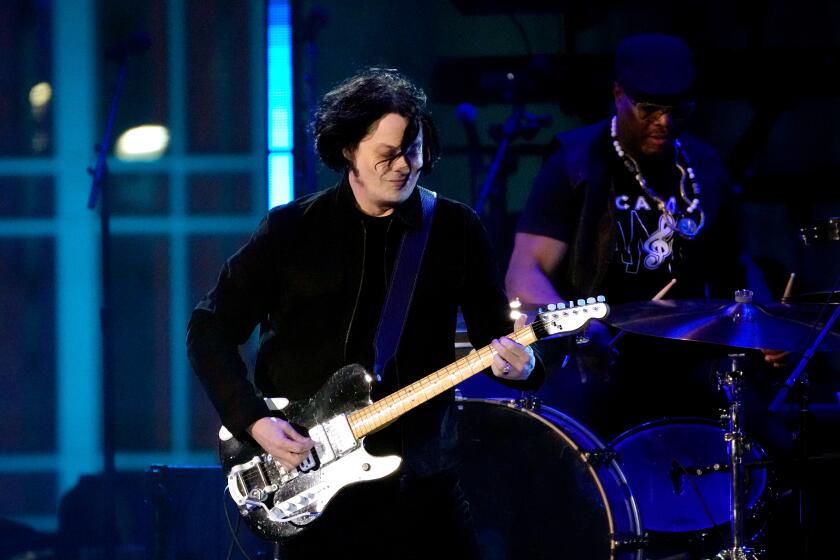SAX QUARTET PICKS DUKE FOR A DEBUT
Although the World Saxophone Quartet may be one of the most acclaimed jazz ensembles of the last decade, the group’s just released sixth album, “The World Saxophone Quartet Plays Duke Ellington,” is its first for an American label.
The quartet, which customarily performs without rhythm section (it appears at the Palace Court in Hollywood tonight and Sunday), was approached by producer Robert Hurwitz of the classically oriented Nonesuch label to record an album of material associated with the late composer-bandleader.
“Our consideration has been to try and make some kind of presentation on an American label,” explained alto saxophonist Julius Hemphill by phone from New York. “We had some other proposals made but they would have required that we alter our format, and we were hesitant about that notion as a prerequisite.
“Bob’s proposal didn’t require any kind of adjustment or rethinking of anything and it was exciting. It was to do some Ellington music, and that is not any kind of labor.”
Even a severe case of jet lag following a recent tour couldn’t entirely dampen Hemphill’s enthusiasm for the new album.
He hopes that the arrangements, written by the individual members of the quartet for standards penned by Ellington or Billy Strayhorn, will attract many new listeners who may have been previously put off by the group’s avant-garde reputation. Longtime fans will discover this first venture into recording outside material hasn’t softened the quartet’s trademark improvisatory daring.
“The challenge is to bring the material into our sensibility, which is not difficult to do because the implications of those Ellington-Strayhorn compositions are vast,” Hemphill contended. “They’re not narrow in any way.
“Duke and Billy’s whole posture was very open to interpretation. Their songs were basically vehicles in an improvisatory sense, to provide colors and textures that put down a particular kind of freedom for improvisers.”
Hemphill, 48, split his attention between music and sports while growing up in the fertile musical environment of Fort Worth, Tex. He picked up experience playing in blues bands and jazz groups and began focusing on his musical career in earnest after moving to St. Louis in 1966 following an Army stint.
Two years later, he played an integral role in developing the Black Artists Group, an interdisciplinary collective that also included future World Sax members Oliver Lake (alto) and Hamiet Bluiett (baritone). Hemphill recorded two albums, “Dogon A.D.” and “ ‘Coon Bid’ness,” in the early ‘70s that were later released on the Arista/Freedom label.
He moved to New York in 1973, and the World Saxophone Quartet was formed in 1976 when a New Orleans promoter individually contacted Hemphill, Lake, Bluiett and tenor saxophonist David Murray to perform together. The planned one-time collaboration proved so successful that it flowered into a full-fledged group.
“We developed some material in preparation for that and decided it had validity so we came back to New York, put on a concert and got roundly put down for not having a rhythm section,” Hemphill remembered. “It was the desirability--the individual and musical satisfaction--of the ensemble that struck us. And our critics, at least the ones in print, have pretty much come around.”
But the near-unanimous critical acclaim the group has enjoyed hasn’t helped it much in America. The ensemble has released five previous albums, one on the Moers label in Germany and four for the highly regarded Italian label Black Saint, and is a major concert attraction overseas.
The World Saxophone Quartet has a live album drawn from its 1985 performances at the Brooklyn Academy of Music tentatively scheduled for release on Black Saint in January. But Hemphill, who is also working on a musical theater piece and an expanded version of the JAH band that released a fine album two years ago, is confident the current album will build bridges to a new, wider audience.
“This is our 10th year and we’ve pretty much fought off the skeptics and won over the audience, but we haven’t had all that much credibility in a lot of areas,” he claimed. “This Ellington and Strayhorn material seems to have made a difference and our treatment of the material is representative of what we’ve been doing all along.”
More to Read
The biggest entertainment stories
Get our big stories about Hollywood, film, television, music, arts, culture and more right in your inbox as soon as they publish.
You may occasionally receive promotional content from the Los Angeles Times.










